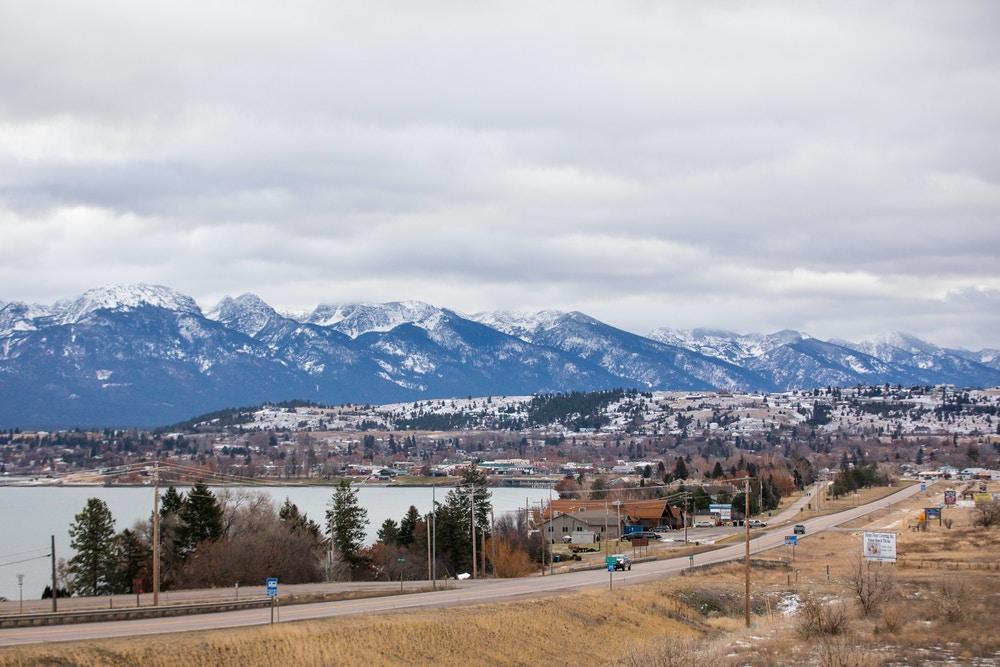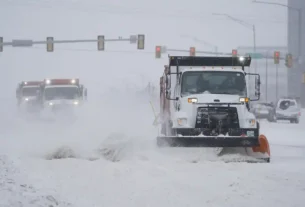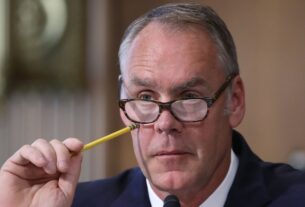
Read this article in The Intercept»
When Montana’s legislature met at the end of December to vote on whether visitors to the state Capitol building should have to wear masks, one lawmaker gave an impassioned plea.
“I have no stomach to talk about this abstractly; my community has been hit hard,” said Sharon Stewart Peregoy, a Democratic state representative and member of the Crow Tribe. “Even today, I just got a notification that another one has passed. It’s real, folks. We should take the basic steps.”
A colleague called her words “emotional” and “insulting.”
“Science does lie. It depends on which science you are listening to. Different news channels have different scientists,” said Republican Rep. Barry Usher. “It’s the facts.”
The Legislature ultimately voted against a mandate along party lines, making mask-wearing optional in Montana’s seat of government a month after the state experienced a Covid-19 surge that topped the charts globally.
For Indigenous communities, it was just the latest public health battle fought and lost during the pandemic.
“It’s the intersection of highly vulnerable people going above and beyond and folks in rural communities who lean more conservative buying into all the garbage that it’s ‘embarrassing to wear a mask,’” said state Sen. Shane Morigeau, a member of the Confederated Salish and Kootenai Tribes. “I don’t think the state leaders realize [the spread] is their fault — or they don’t care, to be honest. It makes me tear up thinking about it.”
Covid-19 has killed Native Americans across the U.S. at nearly twice the rate of white people. But in Montana, Native Americans are dying from the disease at a rate 11 times higher than white residents. When Covid-19 raged through the High Plains this fall, making the state an international hot spot, tribes and reservations closed their businesses, imposed shutdowns, and introduced curfews. Intensive care units reached zero percent capacity, federally run hospitals on reservations were airlifting Covid-19 patients out, and neighboring states stopped being able to receive transfers. Overworked medical staff quit from the stress.
Then-Gov. Steve Bullock, a Democrat, implemented a statewide mask mandate to mitigate the spread, but in many counties, including those bordering reservations, masks are still rejected and public health officials are ignored, putting Indigenous lives in the crosshairs. On January 4, Bullock was replaced by former U.S. Rep. Greg Gianforte, Montana’s first Republican governor in 16 years, adding to concern among tribal leaders and public health experts that the pervasive anti-mask movement will soon become the law of the land.
Fault Lines
Shelly Fyant’s family lost three members to the Spanish flu of 1918 within the span of two days. When Covid-19 began spreading across the U.S., she didn’t want the same thing to happen again. Fyant, chair of the Confederated Salish and Kootenai Tribal Council, helped establish a Covid-19 unified command team in conjunction with neighboring Lake County, where tribal residents buy their food.
“Early on, I could see we were unified to a point,” she said of the relationship. “A month in, it started to deteriorate.”
The tribes closed their Flathead Reservation in Montana’s forested, mountainous West to nonresidents in late March but immediately faced a huge hurdle: The reservation is a checkerboard of land owned by both Native Americans and Montana locals who claimed property rights through homesteading in the 1800s. U.S. Route 93, which links Yellowstone and Glacier national parks, also cuts through the reservation. The tribe asked Lake County to agree to temporarily close the route, but county leaders refused.
In late April, when Bullock decided to reopen Montana but allowed local communities to enforce stricter rules, the tribe again asked Lake County to keep restrictions in place. The county punted. So when Fyant found out that a Fourth of July boat parade in support of President Donald Trump was scheduled in the nearby city of Polson on a lake that abuts the reservation, and that a restaurant called The Shoe was holding a barbecue equipped with “three live bands,” she had a hunch her concerns would go unheard.
“The city basically said, ‘We’re not the pandemic police,’” she recalled.
Almost half of Lake County’s Covid-19 cases are tribal, according to the county public health department. When photos emerged from the Independence Day event, it was clear just how little mask-wearing and social distancing had been implemented, but one person in particular stood out: a blond woman on a Jet Ski wearing a feather headdress, much like the Salish and Kootenai chiefs wear — some of their “most sacred regalia,” Fyant said. Tribal members viewed the act as a direct attack on their small community at a time when families were burying their loved ones in bursts.
“It was gut-wrenching,” Fyant said, looking back. “We have lost so many tribal members. … Families upon families are suffering.”
A Toxic Environment
In Montana, which has one of the smallest populations of any U.S. state, the virus has had an outsize impact on rural Indigenous communities. Native Americans make up just 7 percent of Montana’s residents but have accounted for nearly 40 percent of the state’s Covid-19 deaths. The disparity is largely due to the prevalence of underlying health conditions, such as diabetes, in Indigenous communities and the fact that many people lack access to running water and reside in multigenerational homes.
At least 183 Native Americans in Montana have died from the virus, and more than 8,000 have been infected.
“My dad had three of his best friends pass away within two weeks,” said Kaci Wallette, a registered nurse and member of the Fort Peck Assiniboine and Sioux Tribes in northwest Montana. “He just called me today to tell me he tested positive.”
Her dad’s diabetes and age put him in a high-risk category.
“I try not to let it get me down,” she said. “It’s a very sad time for our tribe.”
There are 12 tribes spread across seven reservations in Montana, and many share borders with some of the fiercest anti-mask counties.
In Flathead County, north of the Flathead Reservation, a public health official quit her job after she said members of the county commission and city-county board of health were creating a “toxic environment” that focused on bolstering political views instead of locals’ health.
“It’s clear that the underlying motivation by several members of your groups is more closely aligned with ideological biases than the simple desire to do what’s best for the health of the community,” Interim Health Officer Tamalee St. James Robinson wrote in her resignation letter in early December.
She was the second person in six months to resign from the county’s health board.
Bullock sued five businesses in Flathead in October over their failure to enforce his mask mandate, but a district judge threw out the case. Those businesses have since launched a countersuit against the state.
In Pondera County, next to the Blackfeet Reservation, all four members of the health department resigned in early November due to pushback from local leaders.
“In order to be successful, I need to be heard and invested in, the lines of communication need to be open, and frequent contact needs to be in place,” Health Department Director Nicki Sullivan wrote when she quit. “Hearing negative talk within the community about myself … should be thwarted and never accepted.”
Health experts in Lake County are facing similar resistance from local authorities. Emily Colomeda, Lake County health services director, said her team has been extremely limited in their ability to enforce the statewide mask mandate. County officials who do have the authority have not enforced the rule, she said, and businesses like The Shoe have taken advantage of the impasse.
“As health directors, we have no authority. We reached out to the environmental health department to look into it. We were met with resistance from the business, I have to say. The county attorney didn’t want to enforce it,” said Colomeda.
Covid-19 cases in the county spiked following the July Fourth holiday weekend. Colomeda said a handful were traced back to the boat parade and dinner at The Shoe.
“We have a very small staff, four, and the tribe is also in the same county, so we share a population, basically,” she said. “It’s a little frustrating that we are working overtime on weekends and evenings and that this is still happening.”
On New Year’s Eve, The Shoe held another bash that offered a four-course meal, live music, and dancing. But Colomeda’s hands were tied.
“It came to the point where we just kind of gave up on that,” she said. “Obviously our efforts haven’t been validated.”
The Only Ones Wearing Masks
With limited state leadership on masks and infighting across counties, reservations have been left to go it alone to keep their populations safe from Covid-19.
“Those of us in public health, and especially anyone who’s worked with Native communities, knew that when [Covid-19] came and hit, it would hit really hard,” said Cora Neumann, a public health expert who supported the 2014 Ebola response in West Africa for the Global First Ladies Alliance, a partnership she founded with the offices of Laura Bush and Michelle Obama.
Neumann is a public health adviser for Western Native Voice, a nonprofit that advocates for Native American communities. She’s been leading online and in-person tutorials and debriefings with tribes on how to mitigate Covid-19 exposure and deal with the stigma surrounding getting sick. She brought in Beth Cameron, who previously headed the pandemic readiness office that Trump disbanded in 2018, to help draft the guidance.
Neumann says tribes have been the true leaders during the pandemic, at times taking the strongest steps to curb the spread of the virus in Montana. But they are still the main victims of the disease.
“When you have the Crow or Northern Cheyenne or Blackfeet locking down and implementing stay-at-home orders for months on end, but the surrounding counties don’t abide, that’s the problem,” she said. “And who gets sick? The Native Americans get sick.”
But it’s not as simple as staying away from those counties. Tribal residents frequently live in food deserts and rely on neighboring communities for gas and other needs. Something as simple as a trip to the mechanic can be perilous.
“We just got our oil changed at one of the car dealerships where we bought our car. When we go in there, we’re probably the only ones that wear masks around. … We just go there as quickly as we can and get out,” said Susan Webber, a state senator and member of the Blackfeet tribe. “Only the Indians are wearing masks.”
The risk of exposure is glaring. In November, the Blackfeet hosted a digital memorial service honoring 27 members who died from Covid-19.
Webber has served in the Legislature for eight years and lived on the reservation her entire life. Tensions between the reservation and surrounding towns have always been tough. She says she’s been a victim of the “lazy Indian” stereotype, recalling an instance in a supermarket where another shopper incorrectly scolded her for “being on welfare.”
“Native Americans are the largest minority in Montana. So we’re the only ones visible. We’re the dark people,” she said. “Until the Trump administration, it used to be kind of covert. Now it’s overt.”
“As an Indian in Montana, you live with discrimination all the time,” she added. Choosing where to go based on who follows the mask guidelines is just another hurdle for her daily routine.
Webber and others are concerned that Bullock’s successor, Gianforte, won’t help bridge the state’s divide on pandemic policies. Gianforte, who was charged with assault for attacking a reporter during his 2018 congressional run, has been criticized for speaking at the Let Freedom Ring concert in October, which officials said violated health guidelines. The concert was linked to multiple Covid-19 cases. He has also promoted the idea of herd immunity as an effective approach to the pandemic.
In a letter to the state Legislature, Gianforte said his office would be taking “commonsense, precautionary” measures and encouraging visitors to wear masks. He said he will wear one in the Capitol building but has not committed to continuing Bullock’s mandate, which required all counties to enforce mask-wearing regardless of active case counts. Gianforte is the only elected governor to take the reins for the first time during the pandemic. He did not respond to a request for comment.
“I generally believe in personal responsibility rather than mandates,” he told a local TV station in December. “I think Montanans will do the right thing when presented with the facts.”
Many remain skeptical.
“In past administrations, when we didn’t have Democratic representation, we’ve seen a little more strained relationships with tribes,” said state Sen. Morigeau, of the Confederated Salish and Kootenai Tribes. “Gianforte, he won, and he deserves the chance to prove me wrong and prove otherwise.”
Webber, meanwhile, said she wouldn’t stick around the Capitol building long enough when the Legislature convened in early January to see whether Gianforte stuck to his mask promise.
“It has the potential of being a superspreader event. We are locked in this one Capitol building for 90 days. About 250 staff. About 200 lobbyists and then every person who wants to testify for a bill comes from every part of Montana.”
“As soon as I swear in, I’m leaving,” she said. “I can’t take any chances of bringing this back home.”


